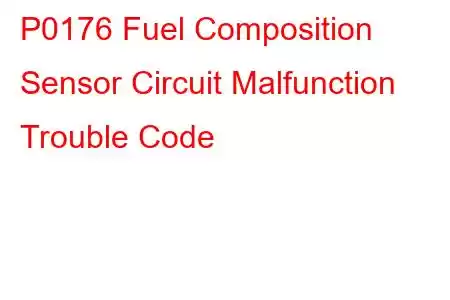P0176 Fuel Composition Sensor Circuit Malfunction
OBD-II Trouble Code Technical Description
Fuel Composition Sensor Circuit Malfunction
What does that mean?
This generic powertrain diagnostic trouble code (DTC) typically applies to all OBD-II equipped vehicles including but not limited to Ford, BMW, Chevy, Pontiac, Mazda, VW, Honda, Scion, Land Rover, etc.
There are four trouble codes commonly associated with fuel composition sensor circuit malfunctions. This circuit is also referred to as the as the flex fuel sensor circuit and the OBDII codes that are triggered by the Engine Control Module (ECM) when this circuit malfunctions are P0176, P0177, P0178 and P0179.
The fuel composition sensor circuit monitors the amount of ethanol in the gasoline on a flex fuel engine. The amount of ethanol can very every time you fill up the tank requiring appropriate adjustments for optimal performance and fuel economy. The fuel composition sensor circuit sends a signal to the ECM based on the ethanol level. The ECM adjusts the ignition timing and fuel injector pulse width accordingly to burn the fuel more efficiently. The end result is improved performance, reduced pollution and increased fuel economy.
Code P0176 is set when the ECM detects any malfunction within the fuel composition sensor circuit.
Trouble code P0176 is triggered by the ECM when it receives a signal that is abnormal or out of range. This code identifies various malfunctions within the circuit and the issue may be physical, mechanical or electrical. In most circumstances the presence of a P0178 or P0179 is a very good indication that the problem is electrical in nature.
Code Severity & Symptoms
The severity of this code is moderate.
Symptoms of a P0176 engine code may include:
Increased fuel consumption Poor performance Check Engine Light illuminated Engine stallsCauses
Typically, potential causes for this code include:
Faulty Fuel Cap Contaminated fuel Faulty Fuel Composition Sensor Corroded or damaged connector Damaged or restricted fuel line Faulty or damaged wiring Faulty ECMWhat are the most common repairs?
Replacing the Fuel Cap Replacing contaminated fuel Cleaning corrosion from connectors Repairing or replacing wiring Replacing Fuel Lines or fittings Replacing the Fuel Composition Sensor Flashing or replacing ECMDiagnostic and Repair Procedures
Note: The first step in the troubleshooting process for any malfunction is to research the Technical Service Bulletins for the specific vehicle by year, model and power plant. In some circumstances this can save a lot of time in the long run by pointing you in the right direction.
Basic Steps
Examine the condition of the fuel cap Examine the condition of the fuel for contamination Visually inspect the circuit connections and wiring Visually inspect the condition of the fuel lines for obvious defects Check electrical connections for security and corrosionAdvanced Steps
Note: The advanced steps become very vehicle specific and require the appropriate advanced equipment to perform accurately. These procedures require a digital multi meter and the specific technical references for the vehicle. Voltage requirements will very based of the specific year, model and engine in the vehicle.
Circuit Checks
With the key in the off position and with the sensor and ECM connected check for power and ground referencing the appropriate technical data. Ground should always read 0 volts and power should be 5 volts or 12 volts based on the vehicle and the system configuration. The specific technical manual or online reference material for your vehicle will guide you through this process. If all of these readings are correct the associated component most likely requires replacement. Frequency checks are recommended in some troubleshooting procedu
Read: 48


